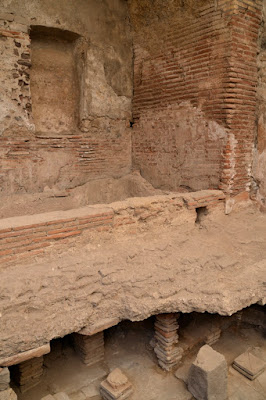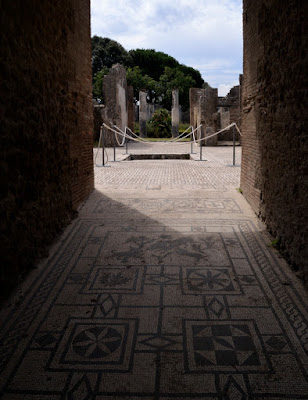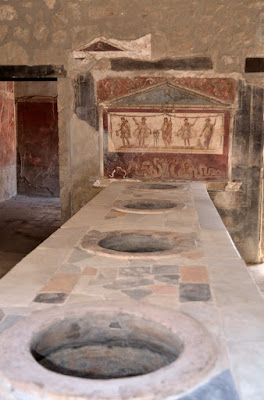One of the highlights of the trip was our visit to the archeological site of Pompeii. Maggie and Dorcas joined the Gagnons on this day-long excursion. We took a commuter train from Sorrento and then booked a private guide for about 3 hours. We then spent another two or three hours exploring the site on our own. The site is massive. It is estimated that about 10,000 to 15,000 people lived in the city when it was destroyed by the eruption of Mount Vesuvius in 79 A.D. and buried under up to 20 feet of volcanic ash. Today, over two million people visit this ancient Roman city every year.
The site consists of the remnants of houses and buildings laid out in a grid-like pattern of streets and broad avenues. A few buildings have reconstructed roofs, and most of the artifacts have been moved to a museum in nearby Naples. So when visiting Pompeii, one gets a feel of the scale of the city, how it was organized, and how people lived. It was very useful to have a knowledgeable guide to provide context and interpretation.
 |
| The ancient Roman city of Pompeii with Mount Vesuvius in the background. |
 |
| The theater is still used today for live performances. |
 |
| Our guide had a Master's degree in Roman history and was very good at pointing out interesting details and providing context. |
 |
| Our guide explaining to Vicki some features of the houses. |
 |
| A street crossing for pedestrians, with the gaps for allowing chariots to pass through. We can still see the ruts left in the stone pavement by the wheels. |
 |
| A section of clay pipe running down from what used to be the second floor of this house. |
 |
| A section of lead pipe that used to bring drinking water. |
 |
| A bath house showing the floating floor with the heated space underneath. |
 |
| This carving on a street flagstone was pointing towards the red-light district. |
 |
| The frescoes above the brothel rooms were perhaps graphic depiction of the kind of services available on the "menu". |
 |
The built-in stone beds in the small brothel rooms were remarkably short. The kids refused to pose for me in the picture to provide a sense of scale. No way Dad!
At least we know they used pillows and cushions for comfort. |
 |
| A public water fountain that still shows the worn area where people would sit to drink and collect water. |
 |
| A mosaic floored passageway leading to an inner courtyard with a small collecting pool. |
 |
| Remnant of a temple in the main town square. |
 |
| Archaeologists at work in one section of the site. |
 |
| This certainly brings back memories of my time spend on digs. |
 |
| A three-legged marble base for a table inside a house. |
 |
| An open-air storage area with hundreds of amphorae and other artifacts, including a cast of the famous dog with his collar still in place. |
 |
| A plaster cast of one of the victims. Those were made by poring liquid plaster in cavities left in the ash bed after the bodies had decomposed. |
 |
| A kind of fast food restaurant. These counters had openings for vessels underneath that contained food or beverages. |
 |
| Another fast food counter, this one with a fresco at one end. |
 |
| Detail of the fresco. Not sure if it represents some of the products on sale. |
 |
| Some remnants of frescoes had text still clearly readable. |
 |
| Another fresco depicting a series of graphic scenes. |
 |
| A small fountain in a yard with an altar, flanked by two very well preserved frescoes. |
 |
| A beautiful fresco depicting Venus emerging from her shell. About 1400 years before Botticelli's Birth of Venus. |
 |
| The large amphitheater at the end of the site complex. I can just imagine Pink Floyd playing Meddle there in the early 1970's. They had a nice little exhibit about that event. |
 |
| Ahh those tourists with their photos... |
 |
| The outside of the amphitheater with the majestic umbrella pines. |
 |
| Tristan listening to his music on the train on the way back. |
Mario






























No comments:
Post a Comment